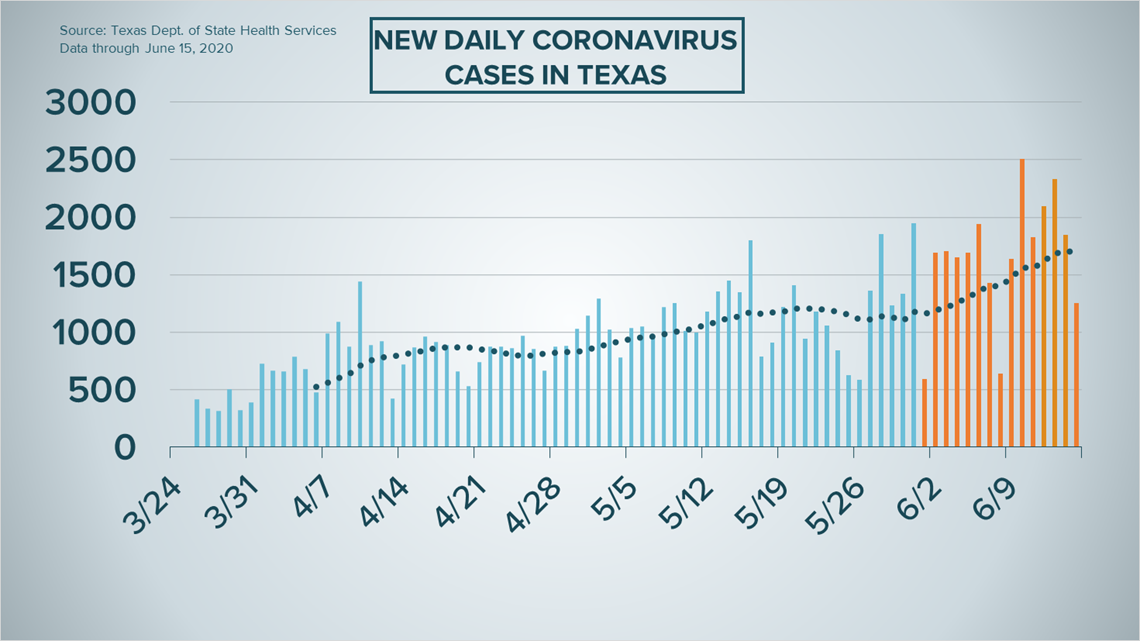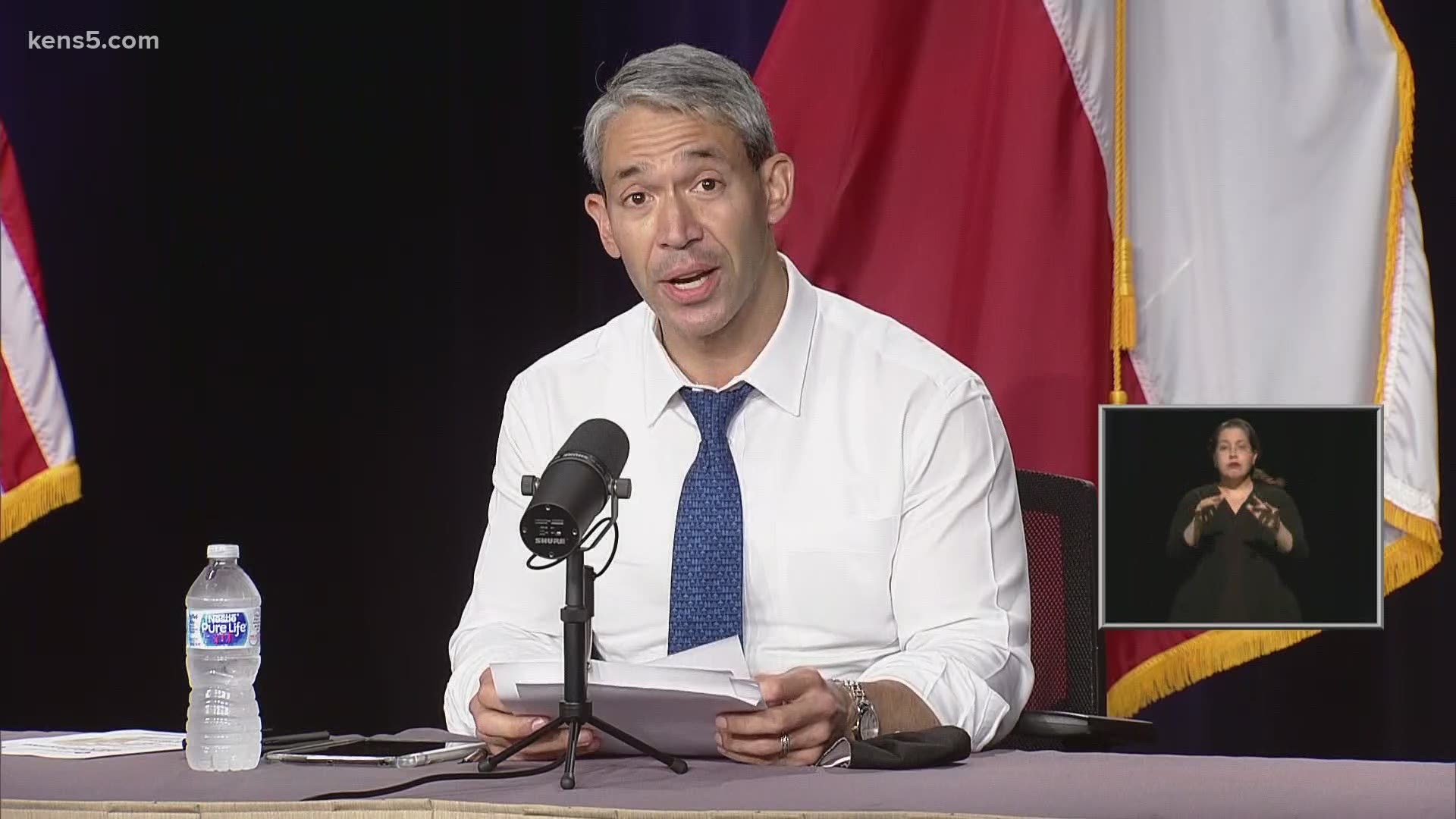SAN ANTONIO — We're tracking the latest numbers from the coronavirus pandemic in San Antonio and across Texas. Here are the latest numbers reported by Bexar and surrounding counties:
- Bexar County: 44 new cases Monday and one fatality; a total of 4,437 cases and 89 fatalities.
- Comal County: A total of 191 cases and seven fatalities; 127 residents have recovered, as of June 13. The county has not reported new numbers since then, as of 7 p.m. Monday.
- Hays County: 69 new cases Monday; a total of 938 cases and five fatalities in the county; 267 residents have recovered.
Bexar County reported 44 new confirmed coronavirus cases on Monday. One new death was reported, so the county's death toll has risen to 89. There are 187 COVID-19 positive patients in area hospitals Monday. Hospitals report 76% of ventilators are available and 26% of hospital beds are available.
In addressing Monday evening's numbers, San Antonio Mayor Ron Nirenberg noted that cases remain under investigation because "folks aren't following up with our contact tracers." Nirenberg urged those who have tested positive for coronavirus to "please help your community by providing necessary information" when Metro Health attempts to follow up on contact tracing.
Nirenberg also urged San Antonians to wear a mask and to not " use the state's reopening plan as an excuse to hold extensive social gatherings or parties."
Here are Monday's full numbers. Bexar County reports them daily at 7 p.m.:
How Bexar County is trending:
We're tracking how many coronavirus cases are confirmed in Bexar County each day from the time San Antonio Metro Health began reporting cases more than two months ago. Graphing those daily case numbers along a 14-day moving average provides an accurate picture of the curve in the San Antonio area and the direction we're heading amid the coronavirus.


Coronavirus in Texas
The Texas Department of Health and Human Services reported an additional 1,254 coronavirus cases and seven fatalities in the state Monday. As of 4 p.m. Monday, Texas health officials have reported 89,108 total cases and 1,983 fatalities. The state estimates that 59,089 residents have recovered, while 28,036 residents are still ill with the virus.
What's troubling, however, is the consecutive days of record hospitalizations in the state. As Texas continues to see historic high COVID-19 cases and hospitalizations, Gov. Greg Abbott announced another record-setting day in the number of daily coronavirus cases, 2,622 cases in total, in a news conference Tuesday, though the official numbers hadn't yet been released by Texas HHS. He said medical professionals are confident in the available hospital bed space to handle the uptick in cases.
RELATED: Gov. Abbott emphasizes mask-wearing, staying home as Texas sets another record for COVID-19 cases
Texas health officials reported 2,326 patients hospitalized for COVID-19 and 1,254 new cases Monday. On June 12, the state saw 2,166 people in the hospital. That number rose to 2,242 on June 13 and 2,287 on June 14.
Here's a look at the 14-day moving average of the new daily coronavirus cases in Texas:


Coronavirus symptoms
The symptoms of coronavirus can be similar to the flu or a bad cold. Symptoms include fever or chills, cough, shortness of breath or difficulty breathing, fatigue, muscle or body aches, headache, new loss of taste or smell sore throat, congestion or runny nose, nausea or vomiting and diarrhea, according to the Centers for Disease Control.
Most healthy people will have mild symptoms. A study of more than 72,000 patients by the Centers for Disease Control in China showed 80 percent of the cases there were mild.
But infections can cause pneumonia, severe acute respiratory syndrome, kidney failure, and even death, according to the World Health Organization. Older people with underlying health conditions are most at risk.
The CDC believes symptoms may appear anywhere from two to 14 days after being exposed.
Human coronaviruses are usually spread...
- Between people who are in close contact with one another (within about 6 feet).
- Through respiratory droplets produced when an infected person coughs, sneezes or talks. These droplets can land in the mouths or noses of people who are nearby or possibly be inhaled into the lungs.
- Some recent studies have suggested that COVID-19 may be spread by people who are not showing symptoms.
Help stop the spread of coronavirus
- Stay home when you are sick.
- Eat and sleep separately from your family members
- Use different utensils and dishes
- Cover your cough or sneeze with your arm, not your hand.
- If you use a tissue, throw it in the trash.
Lower your risk
- Wash your hands often with soap and water for at least 20 seconds. If soap and water are not available, use an alcohol-based hand sanitizer.
- Avoid touching your eyes, nose, and mouth with unwashed hands.
- Avoid close contact with people who are sick.
- Clean and disinfect frequently touched objects and surfaces.
- The CDC recommends wearing a mask or cloth face covering if you have to be out due to an essential service or essential activity such as going to the grocery store.
- If you are 60 or over and have an underlying health condition such as cardiovascular disease, diabetes or respiratory illnesses like asthma or COPD, the World Health Organization advises you to try to avoid crowds or places where you might interact with people who are sick.

